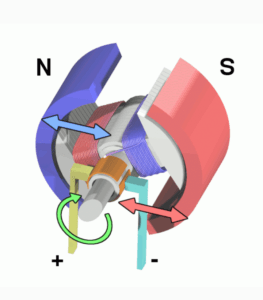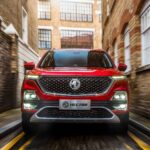Introduction
An electric motor is a device that converts electrical energy into mechanical energy to produce motion. Electric motors operate on the principle that opposite magnetic poles attract each other, while like poles repel. By applying electrical current, the magnetic fields within the motor can be manipulated to generate rotational force. Electric motors are essential components of many devices we use every day, from home appliances to cars, trains, and industrial machinery.

Main components of an electric motor
The main components of a basic electric motor include a rotor, stator, commutator, axle, and drive shaft. The stator is the stationary part containing permanent magnets or electromagnets. The rotor is the rotating part containing the windings which carry the induced current. The commutator helps maintain the direction of current in the rotor windings as it rotates. The axle allows the rotor to spin freely, while the drive shaft transfers rotational force from the axle to operate the load attached to the motor.
How Does an Electric Motor Work?
The working principle of an electric motor relies on three main components – creating a magnetic field, generating motion from the interaction of magnetic fields, and transferring rotational force to a drive shaft.
Creating a magnetic field
Stator
The stator contains magnets or electromagnets arranged to form a fixed magnetic field. In permanent magnet motors, the magnetic field is constant. In electromagnet motors, the magnetic field is produced by passing an electric current through wire windings in the stator.
Rotor
The rotor contains windings of wire that form another magnetic field when electric current passes through. In brushed DC motors, the current is supplied through brushes that press against the commutator on the rotor shaft. In brushless motors, the current is induced magnetically instead of through direct contact.
Generating motion
Interaction between magnetic fields
The key principle that generates rotation is that like magnetic poles repel while opposite poles attract each other. By switching the polarity of the rotor electromagnets by commutation, continuous torque is produced as the rotor magnetic field “chases” the stator magnetic field.
Commutator
The commutator is made up of metallic segments on the rotor which reverse the current direction as the rotor spins. This keeps the rotor magnetic field interacting optimally with the stator field to produce non-stop rotational force.
Producing usable power
Gearing and drive shafts
Gear assemblies and drive shafts transfer the rotational motion from the rotor axle to the load being driven by the motor. The axle spins fast, so gears reduce the speed and increase torque.
Using pulleys or belts
For some motors, pulleys or belts are used instead of gears to transfer mechanical power to the driven device while adjusting the output speed and torque.
Types of Electric Motors
There are two main types of electric motors – DC motors and AC motors. They each have different operating principles and applications.
DC motors
DC motors rely on direct current power from a battery or DC power supply. They have brushes and commutators. The speed can be easily controlled by adjusting the voltage supplied. DC motors provide high starting torque, making them useful for applications requiring variable speed.
AC motors
AC motors use alternating current electricity. They have no brushes and instead use induction or synchronous principles to generate the rotor magnetic field. AC motors include:
Induction motors
Induction motors induce current in the rotor electromagnets through the rotating stator magnetic field. They are robust and inexpensive but cannot operate at variable speeds easily.
Synchronous motors
Synchronous motors rely on rotor magnetic fields being induced directly by external AC current. This locks the rotor precisely to the alternating stator field for constant speed operation.
Applications of Electric Motors
Thanks to their versatility, electric motors have become indispensable in modern society. Some major applications include:
Industrial uses
Electric motors power machines in manufacturing, processing plants, lifts and hoists, and more. Their torque enables large-scale mechanical operations.
Transportation
Electric motors propel trains, electric cars, boats, aircraft, and other transportation systems. High power and precision speed control are essential.
Home appliances
Small electric motors are found in refrigerators, washers, fans, vacuums, power tools, and other household appliances where they provide efficient rotational force.
Conclusion
In summary, electric motors are electro-mechanical devices that produce rotational motion from electromagnetic interactions between the rotor and stator. Variations in design give different types of electric motors specialized qualities suited for specific functions. But all electric motors operate by the same basic principles of generating magnetic fields and precisely controlling their interactions. As an indispensable technology, they will continue to be improved and utilized in every part of our mechanized world.
FAQs
What are the main components of an electric motor?
The main components are the rotor, stator, commutator, brushes, axle, and drive shaft. The rotor spins, the stator is fixed, and the commutator reverses current in the rotor.
How is motion generated in an electric motor?
Motion is generated by magnetic fields in the rotor and stator interacting and pushing against each other as their polarities are changed by the commutator and current supply.
What is the difference between AC and DC motors?
DC motors use direct current and have brushes and commutators. AC motors use alternating current and instead rely on induction or synchronous principles.
What are some common applications of electric motors?
Electric motors are widely used in transportation, industrial machinery, home appliances, and anywhere where mechanical power and precision rotational motion are needed.
Why are electric motors so versatile and useful?
Their ability to convert electrical energy into controllable rotational force with high efficiency makes electric motors adaptable for countless rotating applications.





